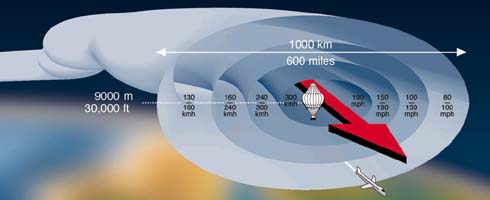 |

|

|

|
The pilots Brian Jones |
Contents |
The concept The meteorological assistance |

|
JET STREAMS THE KEYS TO SUCCESS
The success or failure of the first non-stop round-the-world balloon flight will basically depend on jet streams.

| ||||||
Without the special features of jet streams, meaning their speed and regularity, a non-stop round-the world flight would be unthinkable. Using only the low-altitude winds which drive conventional hot-air balloons, a round-the world trip would require long weeks of flight, implying unrealistic autonomy in relation to existing technology. Relatively little known until the end of the Second World War, this strong high-altitude current Ð blowing at heights of between 7,000 and 12,000 meters (23,000 ft and 39,000 ft) Ð represents an important factor for aviation. Generally moving from east to west, the jet stream is responsible for important gains in time on Europe-bound flights from the United States. By way of example, a plane flying from New York to Paris accompanied by a jet stream of 150 km/h (90 mph) would shorten its flight time by 1h30 compared to the trip in the opposite direction. | ||||||
|
||||||
|
One must try and imagine the jet stream as a flattened tube several hundred kilometers wide, two to four kilometers high and spreading over thousands of kilometers. The highest speeds of 200 to 300 km/h (120 to 190 mph) are at the core of this tube, and it is at such speeds that Breitling Orbiter 3 could at times be driven. |
||||||
|
The jet stream is created by air temperature differences and is always behind a cold front and ahead of a warm front. The higher the difference in temperature, the stronger the wind, thereby leading to strong variations in speed. It is also for this reason that the position of the jet stream changes with the seasons. In summer, in the northern hemisphere, higher temperatures push the jet stream northwards. In winter, the sharper temperature contrast, meaning the wider polar front, leads to the formation of a more powerful, regular and more southerly jet stream. The same phenomenon occurs Ð in reverse seasonal order Ð in the southern hemisphere. Opting for the winter season as the time for Breitling Orbiter 3 to lift off is thus not a choice but an obligation. |
||||||
While the "quality" of the jet stream is better between mid-November and mid-February, the real difficulty lies in pinpointing the ideal weather window for an attempted lift-off. This is the task of meteorologists. Based on models, their role consists in determining which day will feature all the indispensable factors to ensure good conditions for lift-off and flight, meaning no wind at ground level, no rain or snowfall, good direction of winds at medium altitude and a well established jet stream. |
||||||

| ||||||
|
Typically, meteorologists can only provide a realistic forecast over a period of five days. Their work thus becomes even more essential: given that the jet stream is not a continuous tube around the globe, but is in fact fragmented, as shown on this map, meteorologists serve as "remote" guides. In the illustrated example, they must direct the balloon from jet stream 1 toward jet stream 2, by ordering the necessary changes of altitude in order to exploit the direction of winds at low and medium altitudes, while avoiding jet stream 3 which would lead nowhere. For this flight, Meteo Suisse, led by Pierre Eckert and Belgian meteorologist Luc Trullemans, are responsible for guiding the Breitling Orbiter 3 balloon and its crew around the world. The entire meteorological staff will be stationed in the Geneva mission control center and will thus remain in permanent liaison with pilots. |
![]()

|
Brian Jones The pilots |
Contents |
The meteorological assistance The concept |

|


